| |
|
Stanton W. Mead Education and Visitor Center
|
|
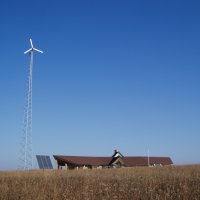
Wind, Photovoltaic, Solar Hot Water Systems & Building
Click on the image above to see an enlarged view
|
|
Renewable Energy is constantly replenished and will not run out. Renewable or "clean energy" can be purchased
as "green" power from local utilities or generated by individuals on-site.
The Mead facility employs both renewable energy generated "on-site", as well as purchased "green"
utility energy produced by wind and other renewable sources.
There are 5 different renewable energy systems incorporated into the design: wind, photovoltaic, solar hot water,
geothermal, and wood biomass.
|
|
Click on the images below to see an enlarged view
|
|
|
|
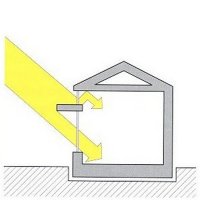
|
Passive Solar Heating & Cooling
Buildings can collect, store and distribute the sun's heat by virtue of their design. An east/west elongated
layout exposes more of the interior to the sun in winter and is easier to shade in summer. The choice and placement
of windows or "glazing" maximizes winter heat gain and minimizes summer heat gain. Additional interior
thermal mass stores the energy and minimizes internal temperature fluctuations. "Direct gain" designs
allow the winter sun to penetrate deep into the interior. "Indirect and isolated gain" designs use a
sunspace or mass wall between the exterior and interior occupied spaces. Passive cooling uses thermal chimneys
and promotes cross-ventilation, often augmented by "whole-house" fans.
The Mead facility utilizes the "direct gain" method, with additional cool daylighting.
|
|
|
|
|
|
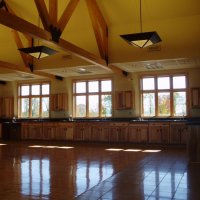
Passive Solar Penetration
|
Distribution Strategies
In "Passive" systems, the mass contained in the building materials absorbs and re-radiates the solar
heat in the occupied spaces. Concrete slabs, tile, masonry and extra-thick drywall or plaster are commonly used
for thermal mass. Proper sizing and covering glazing at night enhances the performance of passive systems. Passive
designs can be in any style but typically have a majority of the windows on the south face. In "Active"
systems, the warmer air or water is distributed through ductwork, hydronic radiators, or hydronic loops in a slab.
Active systems can be combined in tandem with a conventional heating system to provide supplemental heat when desired.
Active designs can also be in any style but building-mounted collector panels often affect roof pitch and appearance.
The Mead facility uses primarily "active" systems for heating & cooling.
|
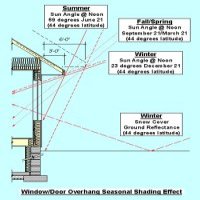
Overhang Shading Geometry
|
|
|
|
|
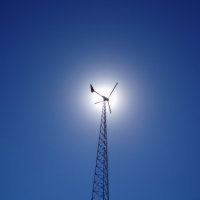
|
Wind Energy
Wind Energy is produced as electricity generated by a wind-turbine, typically mounted on a tall tower to reach
the higher wind speeds present above trees and other landscape features. As with Photovoltaic electricity, it is
generated as DC current that can be stored in batteries or converted to AC current. A wind energy system can be
"off-grid" or "grid-tied" and can also be used in combination with a PV system.
The Mead facility has a "grid-tied" 10 kw Bergey XL wind turbine on a 120' free-standing tower, with
an estimated annual energy output of 8,400 to 10,800 kwh/yr. It uses the utility grid as its "battery storage,"
purchasing energy when needed and selling electricity to the utility when the generated amount exceeds the building's
needs.
|
|
|
|
|
|
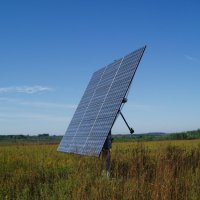
|
Photovoltaic Electricity
Photovoltaic (PV) electricity is converted directly from sunlight. Sunlight strikes the surface of a panel,
generating electricity in the form of "direct" or DC current that is stored in batteries for later use
or used immediately to operate lights, appliances and equipment designed to operate on DC. Since most buildings
use "alternating" or AC current, an inverter is used to convert the DC to AC for conventional use. PV
systems can be stand-alone "off-grid" systems with no utility connection, or "grid-tied" systems
that allow excess electricity to be sold back to the utility. PV systems can consist of fixed panels arranged in
banks of flat collectors or in sets of "tracking" collectors. "Building-Integrated" Photovoltaic
Panels (BIPV) are building elements, such as roof panels, shingles or glazing, that have integral PV components.
PV systems are "modular", with the ability to add panels and expand as conditions allow.
The Mead facility has a "grid-tied" 2.3 kW free-standing pole-mounted dual-axis tracking array, with
18 Kyocera KC125 125 watt panels, with an estimated annual energy output of 3,700 to 4,100 KWH/yr.
|
|
|
|
|
|
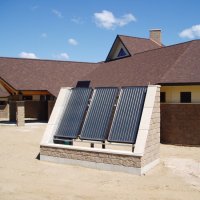
|
Active Solar Heating & Domestic Hot Water
Buildings can incorporate systems to mechanically collect, store and distribute solar heat. One or more collector
panels are used to circulate warm air, water or other liquid through a glazed component that allows a rapid temperature
rise. This heat is then stored in a tank or container and circulated through the interior space. Systems are sized
to provide a major share of the space-heating load or to provide sufficient hot water for domestic use.
The Mead facility has a three-panel ground-mounted solar hot water collector array for domestic hot water, with
a solar photovoltaic pump. It is self-regulating, since the PV pump operates only when the sun is shining.
|
|
|
|
|
|
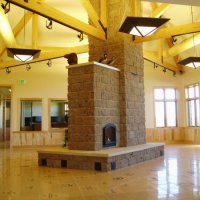
|
Wood Biomass Energy
Biomass energy refers to energy produced from the decomposition of organic material, such as manure and waste from
harvesting crops. Wood energy is stored during the tree's growth. When used properly, advanced-design wood stoves
will burn wood efficiently, producing low emissions and little wasted energy. Some designs use "catalytic"
combustors to provide more complete combustion and reduce pollution, or employ secondary combustion to optimize
the burning of gases by maintaining high temperatures. Other designs utilize wood pellets or other agricultural-based
fuels. Long-term radiant heat storage and distribution can be accomplished with a Central Masonry Heater, that
employs a special refractory masonry core and extended flue/heat-exchange channel to absorb heat from a relatively
short and hot fire. They combine high efficiency and very low emissions.
The Mead facility has a Central Masonry Heater, for radiant heating, with an hydronic heat exchanger for hot water
radiant floor heating. The heated "bench" around the base is actually part of the chimney flue.
|
|
|
|
|
|
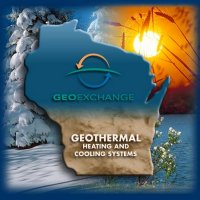
|
Geothermal Heating & Cooling
Geothermal energy utilizes an electric ground-source "heat pump" and the temperature of the earth or
groundwater to store and harvest heat. A "closed-loop" system circulates water or liquid through tubes
buried in trenches or in drilled wells. An "open-loop" system draws water from wells or a body of water
and discharges it to repeat the cycle. The circulated water enters the heat pump at the near-constant ground temperature
and a small fraction of this temperature is exchanged with a refrigerant in the heat pump. The equipment raises
the pressure and temperature and this heat is exchanged with a separate internal water loop. This hot water can
be circulated directly to heat the interior or is used in a water coil in a ducted system for conditioned air..
The process can be reversed for summer cooling to remove excess interior heat and discharge it to the ground.
The Mead facility has 8 closed-loop ground-source heat pumps for heating & cooling. There are 4 water-to-water
units for multi-zone in-slab hydronic-radiant floor heating system, with a 16 ton heating/cooling capacity rating.
There are also 4 water-to-air units for multi-zone ventilation & conditioned-air system, with a 13 ton heating/cooling
capacity rating. Outside the building there are 32 exterior heat-exchange ground loops, each 600' long, buried
8' feet deep, in an area about the size of a football field.
|
|
|
|
|
|
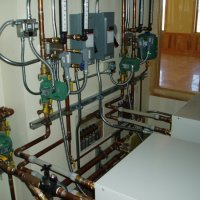
Geothermal Heat Pump Units
|
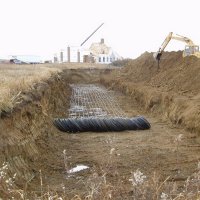
Geothermal Loop Field
|
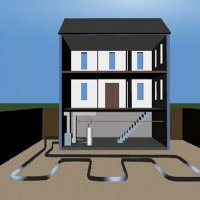
Geothermal Diagram
|
|
|